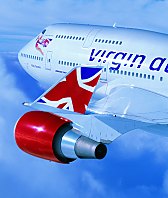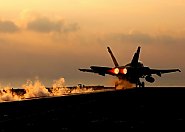Space News: ISS Status Report: 10 June 2005
{From NASA PAO}
Aboard the International Space Station (ISS), the Expedition 11 crew is spending the latter part of its second month in space preparing for the arrival of new cargo. The Station commander quietly slipped into second place on the all time human space endurance list.
Cosmonaut Sergei Krikalev and astronaut John Phillips conducted scientific research this week, while troubleshooting the station's oxygen generator, stowing trash and other unneeded items into the Progress supply spacecraft for disposal next week.
Krikalev, on his sixth voyage into space and third long duration mission (one on Mir and two on the ISS), surpassed fellow cosmonaut Valery Polyakov on the space duration record list. He will become number one in August, passing cosmonaut Sergei Avdeyev (747 days).
This afternoon, the Station passed over the Gulf of Mexico offering flight controllers an opportunity to capture video of Arlene, the Atlantic hurricane season's first tropical storm, as it tracked northward toward the U.S. Gulf Coast.
During the week, Krikalev swapped the large liquid unit component in the Station's Elektron oxygen generation unit in preparation for an attempt in two weeks to restore its use. New filters for its gas lines will arrive aboard the next Progress cargo spacecraft late next week. They will be installed before the crew attempts to reactivate the unit.
In the meantime, the crew continues to replenish the cabin atmosphere daily using two solid fuel oxygen generation canisters. The canisters introduce oxygen into the pressurized compartment by a chemical process. A plentiful supply of canisters is on board the Station, and more will arrive on the next supply ship June 18.
The onboard supply combined with future shipments can provide oxygen for the crew until at least January 2006, even without use of the Elektron. New Elektron components and spare parts are planned for delivery aboard supply spacecraft later this year.
Phillips put on his customized Lycra cycling tights this week for his second session of the Foot/Ground Reaction Forces during Spaceflight (FOOT) experiment. FOOT investigates the differences between use of the body's lower extremities on Earth and in space, and changes in the musculoskeletal system during spaceflight.
Phillips wore the instrumented Lower Extremity Monitoring Suit, which measured his joint angles, muscle activity and forces on the feet during a typical day on the Station. FOOT could help explain the reasons for bone and muscle loss during spaceflight and aid in the design of exercise countermeasures. This experiment also has significance for understanding, preventing and treating osteoporosis on Earth.
Focused human physiological and biological Space Station research on astronaut health and the development of countermeasures to protect crews from the space environment will allow for long duration missions to explore beyond low Earth orbit.
Early next week, the crew will wrap up stowage of trash and unneeded equipment in the Progress docked to the Station, prior to its undocking Wednesday. The Progress departure clears the docking port on the aft end of the Zvezda module for the arrival of the next supply craft. The next Progress is scheduled to launch June 16 and dock the evening of June 18. NASA TV will cover the arrival live. This will be the 18th Progress to dock with the Station.
More Space News
Space News: Space Station: Status Report

Airline News: FAA Investigates NY TRACON - Claims Waste
EDITOR'S NOTE: This item was written by the FAA so take the claims and "facts" with a grain (or block) of salt. It is presented here because the issues raised about safety and waste are extremely important - but - this is a PR piece written by the FAA alone, except where my "Editor's Notes" appear - and my comments are mostly sarcastic nonsense.
As stated below, if the Union has an official response, we'd like to hear from them. If the FAA would like to make Administrator Blakey available for a telephone interview to put some flesh on the bones of this story, we'd also welcome her to appear.
Contact the editor at this link:E-mail the Editor
FAA Investigation Into New York TRACON Uncovers Waste
Operational Errors Did Not Jeopardize Safety
SOURCE: {FAA PAO}
WASHINGTON, DC -- A 60-day on-site investigation of the New York Terminal Radar Approach Control (TRACON) facility found that it is more than adequately staffed for safe operations and that local union-controlled scheduling practices are inefficient and wasteful, creating overtime costs that are more than double any other air traffic control facility in the country. (EDITOR'S NOTE: We welcome a Union response, please contact us.) The investigation also found recent management attempts to curb wasteful practices were met with resistance, followed by anonymous reports of "operational errors."
As a result of the investigation's findings, the U.S. Department of Transportation's Federal Aviation Administration (FAA) is immediately acting to curb scheduling abuses that drive excessive overtime spending, address reports of intimidation and insubordination, and ensure controllers' adherence to existing high safety standards. (EDITOR'S NOTE: If anyone would know about waste, it would be the FAA.)
"The New York TRACON has more than enough staff to get the job done safely" said FAA Administrator Marion C. Blakey. "A schedule that is designed to maximize overtime pay is no schedule at all. The next step is for management to regain control of the daily work schedule and use overtime when traffic requires it."
On March 2, 2005, the FAA assembled a team of over 25 safety experts from around the country, including current and former air traffic controllers, current field supervisors, and human resource and organizational professionals to conduct an onsite operational assessment of the New York TRACON.
The team conducted a thorough audit of radar and voice data, facility scheduling practices, shift assignments, controller time-on-position, and overtime and leave usage. The team's audit also consisted of dozens of interviews with managers, supervisors, and employees and first-hand observation of control room operations.
The investigation showed conclusively that the shift scheduling of air traffic controllers - set through a series of agreements with local National Air Traffic Controllers Association officials beginning nearly 15 years ago - has not met the facility's operational requirements and in fact necessitates much of the scheduled overtime. The need for overtime was compounded, the report found, by absences due to widespread abuse of sick leave and workers compensation claims for stress routinely filed by some controllers. (EDITOR'S NOTE: Is the FAA claiming that working at a New York area TRACON would not be stressful?)
As a result, the New York TRACON, which handles fewer flights with more controllers than most large TRACONs around the country, incurred overtime costs of over $4 million in 2004 - more than double that of TRACONs in Chicago, Southern California, Atlanta and Denver combined. (EDITOR'S NOTE: Now, that is a biggy!)
Generous amounts of overtime allowed 21 controllers to earn more than $200,000 last year, not including benefits; this year, that number is projected to increase to 51. Many controllers logged overtime during weeks in which they also called in sick one or more days, resulting in six-and-a-half days' pay for five days of work, the study found.
The findings come after the FAA took steps to reduce NY TRACON overtime in response to a 2004 report by the U.S. Department of Transportation's Inspector General that found facility employees were manipulating the work schedule and using sick leave and annual leave to inflate overtime payments.
In 2004, the facility acted to reduce the availability of voluntarily-worked "credit hours," and in January 2005, management placed strict controls on overtime usage by controllers and supervisors. Just eight days later, the report said, the FAA began receiving anonymous hotline reports of operational errors. Local NATCA officials also publicly claimed at the time that facility understaffing was jeopardizing safety and launched a campaign to remove the acting manager at the facility - who was taking steps to curb overtime abuse.
The facts and data compiled by the special FAA evaluation team found the New York TRACON has the available staffing necessary to support safe operations and that none of the 160 operational errors - or loss of aircraft separation - reported or uncovered by the team posed any known risk of collision or required the pilot to take action or report a near miss. The operational errors that were classified as most serious under the agency's standards were attributable to performance problems by individual controllers, not staffing levels, the report found.
The report found no evidence of controller fatigue behind those operational errors that were detected; instead, the investigation concluded that controllers at the facility on average worked only 3 hours and 39 minutes a day managing traffic, the lowest of any major TRACON facility.
Many of the operational errors detected were technical violations of the separation standards on final approach, known as "compression errors," that occur when the separation between aircraft lined up for landing is briefly and minimally reduced as aircraft slow down as they approach the airport.
Other operational errors included violations of the strict separation standards for wake turbulence between large, heavy jets and smaller aircraft. Controllers responsible for wake turbulence errors have been retrained.
In response to the team's findings and recommendations, the FAA will take the following actions immediately:
· Restore management responsibility for scheduling of the facility by canceling the agreements that gave the union de facto control
· Appoint the acting manager as permanent manager at the facility effective as of today (2 June 2005 - Editor)
· Transition from an inefficient schedule that necessitates overtime to one used by most other major facilities, which should minimize overtime and save as much as $4 million per year
· Revamp its quality assurance program for controllers and increase supervisor presence on the control room floor
· Curb sick leave abuse, schedule manipulation and workers' compensation abuse
· Ensure a professional environment in the control room, including taking action to address threats and intimidation
· Turn over all evidence of inappropriate behavior to the Inspector General's office
The Administrator has also directed the FAA's Air Traffic Organization and Office of Aviation Safety to develop a more realistic separation criteria and policy on compression errors on final approach that recognizes the balance between safety and efficiency.
The FAA plans to keep in place for an indefinite period of time a special team of safety and human resource specialists to: assist current facility management to carry out these recommendations; to monitor the facility's ongoing performance; and, to ensure safety while these stronger management controls are being implemented.
A copy of the FAA's full report can be viewed here.
More Airline News
Airline News: Safety: Enforcement

Airline News: Safety: Federal Express
{NTSB PAO}
On December 18, 2003, about 1226 central standard time, Federal Express Corporation (FedEx) flight 647, a Boeing MD-10-10F (MD-10), N364FE, crashed while landing at Memphis International Airport (MEM), Memphis, Tennessee.
The right main landing gear collapsed after touchdown on runway 36R, and the airplane veered off the right side of the runway. After the gear collapsed, a fire developed on the right side of the airplane. Of the two flight crewmembers and five nonrevenue FedEx pilots on board the airplane, the first officer and one nonrevenue pilot received minor injuries during the evacuation. The postcrash fire destroyed the airplane’s right wing and portions of the right side of the fuselage.
Flight 647 departed from Metropolitan Oakland International Airport (OAK), Oakland, California, about 0832 (0632 Pacific standard time) and was operating under the provisions of 14 Code of Federal Regulations (CFR) Part 121 on an instrument flight rules flight plan.
FINDINGS:
The National Transportation Safety Board determines that the probable causes of the accident were
1) the first officer’s failure to properly apply crosswind landing techniques to align the airplane with the runway centerline and to properly arrest the airplane’s descent rate (flare) before the airplane touched down; and
2) the captain’s failure to adequately monitor the first officer’s performance and command or initiate corrective action during the final approach and landing.
The safety issues in this report focus on flight crew performance, emergency evacuations, MEM air traffic control and aircraft rescue and firefighting issues, and flight data recorder reliability.
More Airline News
Airline News: Safety: Federal Express

International Space Station Picture: Full Moon
{NASA PAO}
 A full moon is visible in this view above Earth’s horizon and airglow, photographed by an Expedition 10 crewmember on the International Space Station (ISS).
A full moon is visible in this view above Earth’s horizon and airglow, photographed by an Expedition 10 crewmember on the International Space Station (ISS).
Get a hi-res copy for yourself here.
More Space News
Space Picture: International Space Station: Full Moon

Space News: ISS Status Report: 3 June 2005
{From NASA PAO}
 A new capability is being added to the operation of the International Space Station. A final round of tests to commission remote control of the Station's Canadarm2 robotic arm from the ground was completed this week.
A new capability is being added to the operation of the International Space Station. A final round of tests to commission remote control of the Station's Canadarm2 robotic arm from the ground was completed this week.
The 60-foot arm was maneuvered by ground control today to move in, latch onto a fixture on the exterior of the Station, release and move back out. The tests were the second and most complex remote control operations of the arm performed from the ground. The first set of tests completed earlier this year involved only basic movements. Completion of these two phases of commissioning will qualify the ground control capability to be considered for use during future Station operations.
During the tests, the arm was controlled by the robotics officer in the Space Station Flight Control Room of Mission Control. Aboard the Station, Flight Engineer and NASA Station Science Officer John Phillips monitored the activity. Normally, the arm is controlled by the Station crew using a robotics workstation in the Destiny Laboratory.
Other activities this week for the Expedition 11 crew included some brief additional troubleshooting of the Elektron oxygen generation unit. At the direction of Russian flight controllers, Commander Sergei Krikalev tightened a valve in the unit, attempted to pressurize the system and checked for leakage. Similar attempts may continue in the future using other Elektron components and additional monitoring. The Elektron, a system that can derive oxygen from water for use in the Station atmosphere, remains broken.
The crew continues to replenish oxygen aboard the Station daily using two solid fuel oxygen generation canisters, which contain chemicals that release oxygen when heated. Plentiful supplies of oxygen remain aboard the Station, and more is set to arrive on the next supply spacecraft later this month.
With reserves onboard the Station, plus those planned to arrive on future supply ships, oxygen is available for the crew until at least January 2006; even without use of the Elektron. New Elektron components and spares are planned for delivery by supply ships later this year.
Phillips conducted the Miscible Fluids in Microgravity experiment this week. The experiment studies how miscible (mixable) fluids interact without the interference of gravity. Studying the interactions between molecules that make up liquids is important for improving numerous processes ranging from making plastics to manufacturing medicines.
For the first part of the experiment, Phillips used a syringe to inject dyed water into honey. Investigators want to see if they merge into one stream of honey. Under normal gravity, the stream would sink. In weightlessness, the stream can be formed, but it is not known if the stream will break up like a stream of oil in water.
For the second part, Phillips injected an aspherical drop of water into the honey. The process was videotaped for 30 to 40 minutes and digital images were taken for two hours. Investigators on the ground were able to watch video of the experiments, as they were conducted in space. The results will be compared to computer simulations performed by the payload developers.
Next week, the crew will begin packing trash and unneeded equipment in the Progress cargo spacecraft docked to the Station. The Progress will be undocked on June 15. The next cargo vehicle will launch on June 16 and dock to the Station June 18. The crew is scheduled for light duty this weekend, including routine housekeeping tasks and family conferences.
More Space News
Space News: Space Station: Status Report

Airline News: Virgin Atlantic Thinking Outside The Bento Box
 Virgin Atlantic proves once again that the "invented here" mindset established by Sir Richard Branson fosters innovative thinking, services and success.
Virgin Atlantic proves once again that the "invented here" mindset established by Sir Richard Branson fosters innovative thinking, services and success.
They enjoyed an annual pre-tax profit of $123.65 million (£68 million), up from $38 million.
Adding to their earlier in-flight Spanish language offerings, VA is now providing Japanese lessons to passengers heading off to Japan.
Sir Richard's Wise Airways
More Airline News
Airline News: Service: Virgin Atlantic

Space News: Apollo 11 Astronaut Armstrong Peeved Over Clip
Apollo 11 Astronaut Neil Armstrong is mighty angry at his former barber according to a story in the Associated Press.
The AP says Armstrong is threatening to sue the hair cutter thanks to the barber's clandestine collection and subsequent sale of the moonwalker's locks to a celebrity hair collector. (Yuck!)
The contraband clippings supposedly fetched the barber all of $3,000; most of which is now gone on legal expenses since the kerfuffle broke out.
Armstrong's lawyer is demanding the hair back and, or, the money (for a charity selected by Armstrong).
The Full Story
On a purely personal note, in my misspent youth as an aerospace photojournalist, I once ran into the famously uncooperative Armstrong at an NBAA show.
One of my first memories as a child was that of watching the Apollo 11 mission flicker its black and white images into my riveted eyeballs.
The experience no doubt influenced and inspired my life. So when introduced to him by a colleague and professional associate of his, I very politely asked for his autograph.
From his reaction, you'd of thought I'd asked to give him the medical exam depicted in the movie The Right Stuff.
In the end, he did sign the program I'd handed to him.
Now I'm not some celebrity hounding autograph hunter. But the first human to walk on the moon, well, that's a biggy.
Armstrong bravely agreed to serve that role in those most hazardous and experimental days of spaceflight. But he was also privileged to enjoy that perpetually exclusive title of first human, heck, life form, from earth, to set foot or paw on another planetary body, if that is the correct way to reference a moon.
So find another barber Mr. Armstrong. But when you hear some young (or older) person tell you how much they appreciate all you've done and how inspired your amazing, brave and heroic service to our nation and planet have been, try to smile. And find your happy place.
More Space News
Space News: Astronauts: Neil Armstrong

Airline News: Airbus A380 Delay Hits Qantas
While it should surprise nobody, it is now official that the massive effort to deliver the Uber Jumbo Airbus A380 is behind schedule.
The expectation of delay comes not because of any specific error or flaw on the part of Airbus, but simply because the development of any new type of aircraft, let alone one of this grand scale, tends to run into difficulties and thus some schedule slips.
The specific causes for the setback(s) are unclear. It is very apparent that this trouble is going to cost Airbus - literally:
From a Qantas Press Release Issued 1 June 2005 -
Qantas today confirmed that the delivery of its first A380 would be delayed by six months as a result of manufacturing issues at Airbus.
The Chief Executive Officer of Qantas, Mr Geoff Dixon, said the airline was now scheduled to take delivery of the first of its 12 new A380 aircraft in April 2007.
"This is disappointing, given that we have met all of Airbus' deadlines for Qantas specifications, however we are developing contingency plans to ensure there is no impact on our schedules or available capacity during the six month delay."
Mr Dixon said possible contingencies under discussion included deferring the retirement of a number of aircraft, redirecting capacity, and bringing forward the delivery of other aircraft on order.
Mr Dixon said that all airlines with early A380 orders were in the same situation, and that Airbus had advised that the deliveries would be made in the same sequence with the same time differentials.
"We will be working closely with Airbus to ensure the new deadline is met," Mr Dixon said.
He said Qantas would also be seeking compensation from Airbus in line with the terms of its contract.
Singapore Airlines has also indicated its A380 deliveries are likely to be behind schedule.
In other Airbus A380 news, Flight International Magazine says the 560 ton (max take off weight) aircraft's advanced composite wheels and related brake system are also behind schedule due to industrial issues. The first four aircraft are apparently flying with aluminum gear as a stopgap measure.
More Airline News
Airline News: Aircraft: Airbus A380

 The subscribers-only "Flying Colors" section of AeroSpaceNews.com has been updated with the addition of a ten image photo essay on the US Navy/Marine Corps/Boeing F/A-18 Hornet operating at sea.
The subscribers-only "Flying Colors" section of AeroSpaceNews.com has been updated with the addition of a ten image photo essay on the US Navy/Marine Corps/Boeing F/A-18 Hornet operating at sea. A full moon is visible in this view above Earth’s horizon and airglow, photographed by an Expedition 10 crewmember on the International Space Station (ISS).
A full moon is visible in this view above Earth’s horizon and airglow, photographed by an Expedition 10 crewmember on the International Space Station (ISS). A new capability is being added to the operation of the International Space Station. A final round of tests to commission remote control of the Station's Canadarm2 robotic arm from the ground was completed this week.
A new capability is being added to the operation of the International Space Station. A final round of tests to commission remote control of the Station's Canadarm2 robotic arm from the ground was completed this week. Virgin Atlantic proves once again that the "invented here" mindset established by Sir Richard Branson fosters innovative thinking, services and success.
Virgin Atlantic proves once again that the "invented here" mindset established by Sir Richard Branson fosters innovative thinking, services and success.